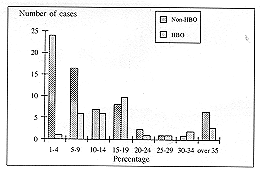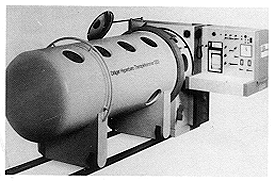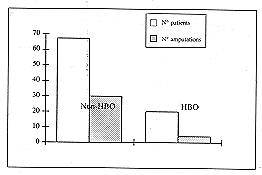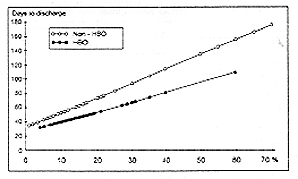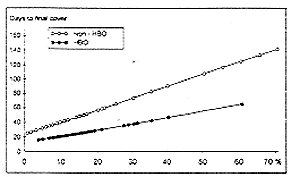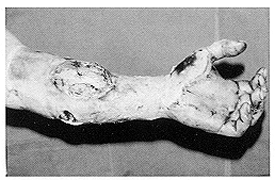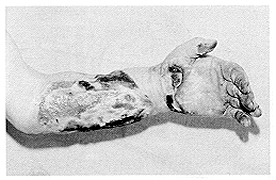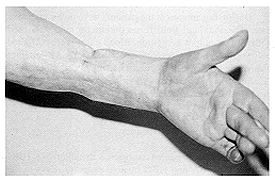Annals of Burns and Fire Disasters - vol. XIII - n. 4 - December 2000 ADJUNCTIVE HYPERBARIC OXYGEN TREATMENT OF SEVERE ELECTRICAL INJURIES: A COMPARATIVE STUDY IN HUMANS Colic M. M Clinic for Burns, Plastic and Reconstructive Surgery. Belgrade, YugoslaviaeSUMMARY. The action of hyperbaric oxvaenation (HBO) on high-tension electrical injuries as an adjunctive treatment is presented in this report, as applied in 30 patients compared " ith 67 patients treated in a standard way. The results were compared using as parameters overall mortality, the number of amputations. and the time necessary before final coverage of the defects and discharge from hospital. Exposure to hyperbaric oxygenation permitted faster and better healing of the affected areas with no secondary infections, a lower amputation rate. and better reconstructive possibilities in the HBO group than in the group of patients treated conventionally. Introduction and general characteristics The action of hyperbaric oxygenation (HBO) on severe electrical injuries is presented in this report. This kind of injury is not very different from thermal injury because of the presence of heat, which is the principal cause of damage, although it has its own characteristics as well. Electrical resistance in all tissues except bone and skin is relativelysmall and the body thus acts as a volume conductor where the heat is generated as a function of voltage drop and current flow per unit of the cross-sectional area. Current flow is markedly affected by the resistance of the skin at the points of entry and exit.As a unique and devastating form of thermal trauma. electrical injury is the perfect union of a skin burn and deep tissue destruction that is unpredictable in its depth and extent. As a result of progressive tissue necrosis, it is usually similar to crush injury Patients and methods The use of hyperbaric oxygen as an adjunct in the treatment of electrical injuries was introduced at the Zemun-Belgrade Clinical Hospital in 1986. At the same time other patients with electrical injuries were treated conventionally in the Clinic for Burns. Plastic and Recon structive Surgery at the Belgrade University Clinical Centre. The same treatment was applied in both hospitals. with an adjunct of HBO in the former of the two hospitals, and we thus had the opportunity to study a group of patients treated with HBO and to compare them with a non-HBO treated group that \\ as managed concomitantly in two different burn units, but with the same surgical procedures and ancillary therapy.Although the patients were not allocated to the treatment and control groups randomly. the two Groups were essentially similar, as can be seen from the age ranges and the surface areas of the electric burns (Figs. 1, 2). Altogether 67 patients were treated conventionally and 30 patients were treated with HBO.Patients treated with HBO adjunctive therapy were placed in a Dr5aer 1200-type hyperbaric chamber every day for ten days (Fig. 3). The time of compression was 20 min and the length of stay in the chamber was -10 min at a pressure of 3 ATA. The percentage of oxygen in the atmosphere of the chamber reached 90% by the end of each treatment. Decompressions mere performed according to standard procedures. The regime of time spent in the chamber at 25 °C was at a humidity of 85%, which \\e consider optimal.During this treatment the patients were under intensive care. The Parkland fluid resuscitation formula was used with urinary output as a guide. Blood gases Nvere corrected before the patient entered the chamber. An attempt was made to keep the patients's temperature under 38.5 °C, but in septic patients whose temperature rose higher the pressure was lowered to 2 ATA in order to prevent oxygen toxicity.
Results Comparing 30 patients subjected to adjunctive HBO therapy with 67 non-HBO-treated cases (Table I). the mortality rate was three deaths in the HBO group (10.0%c ) and ten deaths in the non-HBO group (14.9%). The average number of days in hospital was -19 in the HBO group and 59 in the non-HBO Group, while the average number of days before the final surgical procedure was 28 in the HBO Group and -l5 in the non-HBO group.The number of amputations was also reduced in the HBO group (4 out of 30, i.e. 13.39c), compared with 20 out of 67 patients in the non-HBO group ('29.8%), as shown in Fig. 4. The level of safe amputation was significantly lower in the HBO group. and the time needed for this also vas reduced by 30%. All amputations in this group were definite with no need for reamputation due to false assessment of time or level of demarcation. Figs. 5 and 6 demonstrate the trend lines of both methods. showing the number of days before discharge and of days before the final surgical procedure in relation to the percentage of total body surface area (TBSA) burned. It is evident from both figures that fewer days were required before final coverage of exposed areas and discharge from hospital in the HBO group than in the non-HBO Group. which was in effect one of this methods main aims.
Discussion Hyperbaric oxygenation provides a better oxygen supply and oedema reduction in regions affected by electrical injury. Much faster epithelialization and, in general,regeneration and definite healing were observed in cases treated with adjunctive HBO therapy. Although the average number of hospitalization days was ten days less in the HBO group, in some of the very difficult cases in both groups with 20-40% TBSA the difference in the number of hospitalization days was as high as 15 to 20.There were no cases of secondary infection in the HBO group, while the time for spontaneous demarcation (Figs. 7-9) was reduced by some 30-50%, i.e., 5 to 6 days when either spontaneous epithelialization or definite amputation or necrectomy could have been safely performed.
In such cases HBO served very efficiently as a protection against secondary infection, owing to its bactericidal effect, as a possible protective measure against dehydration and as a stimulus for the regeneration of the production of new bioenergetic potentials of damaged cells, compensating for the oxygen supply deficit caused by the disorder in geometry of prostacyclins and thromboxane which led to intravenous coagulation and the impossibility of supplying oxygen to a very wide area.In conclusion, we can state that exposure to hyperbaric oxygenation facilitates subsequent work in the affected areas, compensates for oxygen deficits, and ultimately ensures a faster, easier, and cleaner procedure in cases of extensive electrical injuries. Essentially this means a faster recovery, shorter hospitalization, and better function of the extremities.
RESUME. L'Auteur decrit Faction de 1'oxygenation hyperbarique (OHB) sur les lesions electriques à haute tension comme traitement supplémentaire. Il présente 30 cas et les compare avec 67 cas traites en manière conventionnelle. Les resultats sont confrontbs utilisant comme paramètres la mortalite globale, le numéro des amputations, et le temps nbcessaire pour arriver à la couverture finale des lbsions et à la sortie de l'hópital. L'exposition A 1'oxygenation hyperbarique a permis dans le groupe OHB une guerison meilleure et plus rapide des zones atteintes sans la manifestation d'infections secondaires, un taux d'amputation inferieur et des possibilitbs supbrieures de reconstruction par rapport aux patients traites en manière BIBLIOGRAPHY
|

